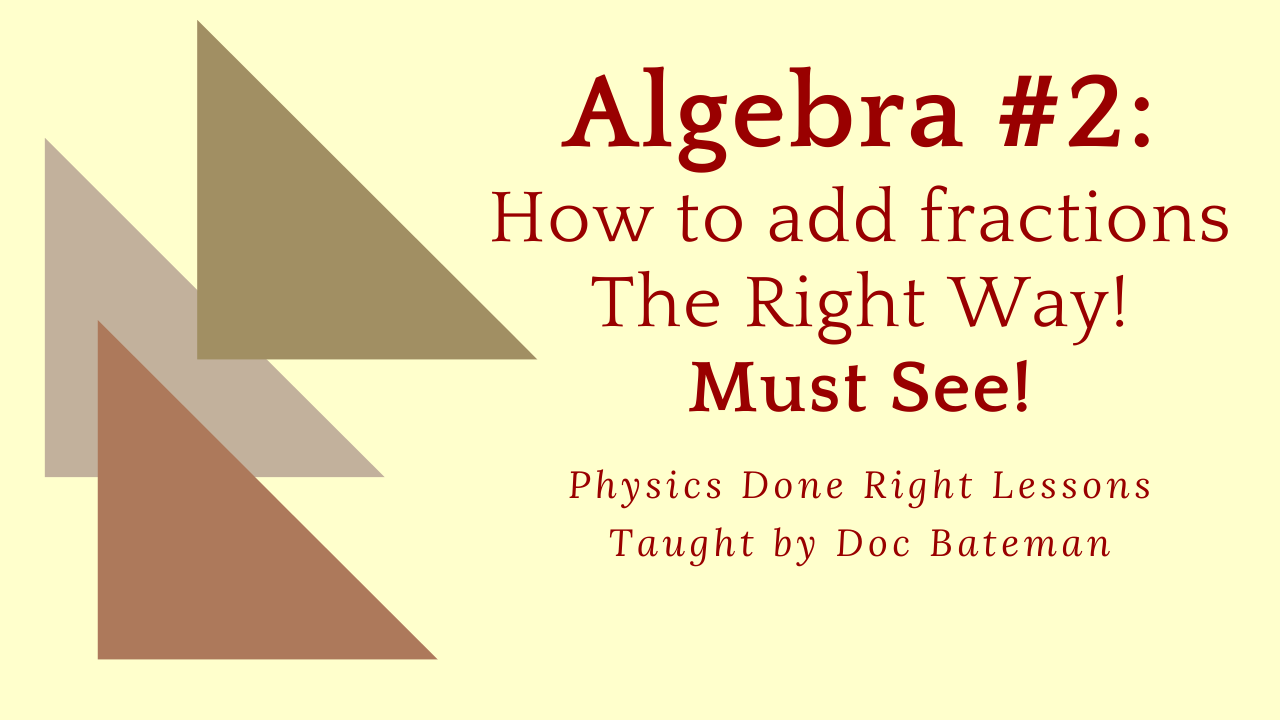A math refresher on Algebra, Part 2.
Learn the absolute best way to add, subtract, multiply and divide fractions. No common denominator needed!
Be sure to get the free worksheet that goes with this video!
Transcript
Hi there, Doc Bateman here. This is the lesson that many of you have been asking me to do. If you struggle with fractions, this lesson is pure gold! I will teach you the right way to calculate with fractions, and you’ll find out why the words common denominator are forbidden in my house! You’ll soon see why. Don’t miss this lesson! And if you get value from my videos, please like and subscribe them below. Then you’ll get a notification whenever I publish a new video. If you have a friend that might benefit from this content, please share it with them. Leave me questions in the comments below. Let’s get started.
Let’s talk about adding and subtracting fractions. You’ve probably been taught to add fractions, you first have to find a common denominator. I’m here to tell you that it’s absolutely not true, and that is the absolute wrong way to do it. I’m going to show you the right way, which is so much easier you’ll wonder why you were never shown this before. If I want to add a/c + b/d what do I do? The answer is I cross multiply! So here we go a/c + b/d. Cross multiply so what I have is a * d, put my plus sign in here, b * c, over the two denominators multiplied together, c * d, and that’s it. Cross multiply a*d + b*c, all over the two denominators multiplied together. That’s how you add fractions. Once that’s done, then you reduce if you need to.
So let me show you an example with numbers: 1/5 + 2/3 = I’m going to cross multiply one 1 * 3 + 2 * 5 over the multiplied denominators 3 * 5. This equals 3 + 10 over 15 which is 13/15, and that’s the answer. No common denominator, no thinking, worrying, wondering, how to figure out a common denominator. Just do it this way and you’re done immediately. Here’s another example: 1/6 + 3 / 4. I cross-multiply 1 * 4 + 3 * 6 all over 4 * 6 = (4 + 18) / 24. That is 22 over 24. I can reduce to 11/12 and that’s the answer. Another example: 3/8 + 2/3 cross multiply 3 * 3 + 2 * 8 all over 8 * 3. I get (9 + 16) / 24 which is equals 25/24. And one more: 2/7 + 1/2 again cross multiply. Now I have 4 + 7 over 14 which equals 11/14.
What about subtraction? Subtraction works exactly the same way except you put in a minus sign. Here we go: a/d – c/b cross multiply: a * b now you put in a minus sign c * d over the multiplied denominators and that’s the answer. Let’s look at an example: 3/4 – 1/8 =? Cross-multiply 3 * 8 – 4 * 1 over 4 * 8 so what I have is (24 -4)/32 so this equals 20/32, which I can reduce to 10/16. I can also reduce that again to 5/8 and I’m done. Let’s do another one 5/6 – 1/3 = ? Cross-multiply 5 * 3 – 1 * 6 over 6 * 3 this is (15 – 6)/18 = 9/18 which reduces to 1 / 2. Here’s another example 9/16 – 1 / 2. Cross-multiply 9 * 2 – 1 * 16 / 16 * 2 = (18 – 16) / 32, which equals 2/32 or 1/16. Let’s do one more: 3/4 – 1/6 =? Cross-multiply 3 * 6 – 1 * 4 over 4 * 6 now work it out (18 – 4)/24 equals 14/24, which reduces to 7/12, and that’s the answer.
Now let’s talk about how to multiply and divide fractions. If you multiply fractions you simply multiply top times top divided by bottom times bottom. So that means a/d times b/c simply equals a * b over c * d. So let’s do it with numbers. Another way to think of this is that the times symbol means “of.” Say we want to calculate 1/2 of 3 / 4; that means the equation we write down is 1/2 * 3 /4. So just as we saw, 1/2 * 3/4 equals 1 * 3 over 2 * 4, which is 3 / 8. Here’s another example: 2 / 3 * 5 / 6 = 2 * 5 / 3 * 6, which equals 10/18, which equals 5/9. Here’s another example 7/16 * 3/4 = 7 * 3 / 16 * 4, which equals 21/64.
To divide fractions you simply invert and multiply. What does that mean? To take a/c divided by d/b, we invert and multiply. So you leave the first one alone, write a multiplication sign then invert the second one so it becomes b/d and now we just multiply, which is simply a * b / c * d. Let’s do it with numbers 1/3 divided by 1/2 we invert and multiply so it’s 1/3 * 2/1 which is (2 * 1)/(3 * 1), which is 2 / 3. Let’s do another example: 3/4 divided by 1/6 =? Write your first fraction again 3/4 * 6/1 = (3 * 6) / (4 * 1) = 18/4, which equals 9/2 and of course we can reduce or rewrite an improper fraction as a mixed number. So 2 goes into 9 four times with one left over, or 4.5. One more example: 7/16 divided by 2 / 3. Write your first fraction down again times the inverted second one giving (7 * 3)/(16 * 2) = 21/32.
In summary, you need to get comfortable with these concepts. You need to be able to do them without thinking about them and it will speed up your algebra work, which is very important in physics. Think of the equals sign as the balance point of the equation — like a seesaw. For added or subtracted terms, when they cross the equals sign and they change sign; for multiplied terms, top goes to bottom and bottom goes to top. Again you need to get to where you can do these without thinking about them.
So now you know my technique for adding and multiplying fractions. I hope this helped you learn a much easier way to do this and removed the fear when adding or subtracting: cross multiply. When multiplying: top times top over bottom times bottom; when dividing invert the second fraction and then just multiply. If you get value from my videos please like and subscribe below. Then you’ll get a notification whenever I publish a new video. Leave me questions in the comments below. Thanks for watching.



